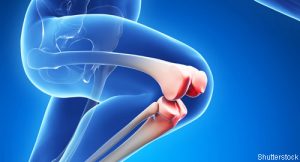 A phase 2b/3 study in Arthritis & Rheumatology highlights the potential of fasinumab, a monoclonal antibody that targets nerve growth factor, to treat osteoarthritis (OA) pain in patients who are unresponsive to or unable to take other therapies.1 Questions remain about the risk/benefit profile of agents in this therapeutic class, but low doses may provide part of the answer.
A phase 2b/3 study in Arthritis & Rheumatology highlights the potential of fasinumab, a monoclonal antibody that targets nerve growth factor, to treat osteoarthritis (OA) pain in patients who are unresponsive to or unable to take other therapies.1 Questions remain about the risk/benefit profile of agents in this therapeutic class, but low doses may provide part of the answer.
Unmet Need in OA Treatments
Alan J. Kivitz, MD, one of the study’s authors, is president of the Altoona Arthritis and Osteoporosis Center and Altoona Center for Clinical Research and a practicing rheumatologist in Duncansville, Pa. He describes the tremendous need for new OA treatments for patients who are not good candidates for, or respond inadequately to, existing therapies.
“Over the course of my years of practicing rheumatology, I’ve seen the use of non-steroidal anti-inflammatory drugs [NSAIDs] and cyclo-oxygenase-2 inhibitors that initially had great promise, until some of their significant, potential toxicities were recognized. Therefore, they are often not ideal medications for many of our patients,” he says.
Dr. Kivitz adds, “I’ve also seen how we went through a phase of opioid use, which obviously is now in disfavor because of our current opioid epidemic [in the U.S.]. The major interventions we’ve had in terms of oral medication, systemic medications for treating systemic pain of OA are now not good options for many of our patients.”
Nerve Growth Factor & Inhibitors
Nerve growth factor was first observed in the 1950s and recognized for its role in the development of the nervous system. Since that time, its role in the mediation of both acute and chronic pain has increasingly been recognized, including such mechanisms as the sensitization of peripheral nociceptive terminals and the new sprouting of sensory nerves. These mechanisms have made nerve growth factor an attractive target for interventions blocking the nerve growth factor signal.2
However, nervous system cells are not the only ones involved in nerve growth factor signaling. Many non-neuronal cells produce or respond to nerve growth factor, such as chondrocytes and bone cells, potentially complicating side effects profiles of such therapies.1-3
In 2010, the interest in this class of treatments increased after the first well-powered and controlled trial of another anti-nerve growth factor therapy for OA, tanezumab.4 Soon thereafter, however, findings of osteonecrosis and rapidly progressive OA were reported in patients who had received these treatments, and autonomic nervous system damage was noted in preclinical models. These findings prompted the U.S. Food & Drug Administration to place a moratorium on clinical trials of all nerve growth factor antagonists. This moratorium was lifted in 2015, after the enactment of certain research parameters.2,3
“We’ve recognized that there seems to be some very significant efficacy with nerve growth factor inhibitors that has been limited by the toxicity profile,” says Dr. Kivitz. He adds that in some people with OA, their disease rapidly progresses in response to these agents, sometimes causing severe symptoms and necessitating joint replacement. The risk of these toxicities appears to be dose related.
Recent Fasinumab Study
The authors designed the prospective study to assess the efficacy and safety of fasinumab, with emphasis on the product’s joint safety. Participants had moderate or severe OA pain in the knee or hip. All had found inadequate relief with other treatments, such as acetaminophen, NSAIDs or opioids, or were unable or unwilling to take other treatments.
Participants received either placebo or subcutaneous fasinumab in doses of 1, 3, 6 or 9 mg, every four weeks for 16 weeks. Participants were then monitored for an additional 20 weeks. Because previous research demonstrated the risk of rapidly progressive OA is greater when NSAIDs are used concurrently with nerve growth factor inhibitors, patients were not permitted to use NSAIDs until at least 16 weeks after stopping fasinumab.2 A total of 342 participants completed the study.
Dr. Kivitz says, “This study had radiographs that were done routinely or for cause, and MRIs were performed to have active surveillance of any negative joint changes that may be occurring as a consequence of nerve growth factor inhibition.”
Imaging was performed at prescreening, end of treatment and week 36, as well as at additional times during the study if participants reported increased pain.
Efficacy: Participants taking fasinumab showed clinically relevant and statistically significant reductions in pain compared with those taking placebo as assessed by the pain subscore of the Western Ontario and McMaster Universities Osteoarthritis Index (WOMAC). These reductions in pain scores were noticeable from week 2 and continued throughout treatment. There was no clear relationship between fasinumab dose and degree of WOMAC improvement.
Similarly, all doses of fasinumab showed clinically meaningful and statistically significant differences in WOMAC physical function scores. The Patient Global Assessment scores were also reduced from baseline at all doses. Patients who had higher pain initially or who had previously had greater worsening after withdrawal of analgesic showed greater treatment effects overall.
Treatment-emergent adverse events: As a combined group, the fasinumab participants had a higher incidence of arthralgias (8% vs. 2%) and a higher incidence of worsened arthropathies (7% vs. 1%) than the placebo group. Five percent of the participants in the fasinumab group showed rapidly progressive OA with joint space narrowing on imaging, whereas no patients in the placebo group did. Overall, a dose-response relationship emerged, with one arthropathy in the placebo group, two in the 1 mg fasinumab group, four in the 3 mg fasinumab group, six in the 6 mg fasinumab group and 12 in the 9 mg fasinumab group. In this sample, no difference was found in the rate of joint replacement between the fasinumab and placebo groups, and primary osteonecrosis was not seen in either group.
The combined fasinumab group had a higher incidence of paresthesias compared with the placebo group (3% vs. 0%). Of the 12 paresthesia events, 10 were mild and two were moderate; none were severe. No incidents of sympathetic nervous system dysfunction were found.
“Paresthesia is something that’s recognized as a consequence of nerve growth factor inhibition,” says Dr. Kivitz. “Most, but not all, are reversible, and most are mild to moderate.”
Overall, few participants discontinued fasinumab due to the side effect profile. “The results were interesting in that we did not see an expected dose response for the efficacy, but we did see an increase in adverse events of concern as the dose increased,” says Dr. Kivitz. “This [finding] suggests we need to concentrate our efforts on the lowest doses for this and other nerve growth factor inhibitors.”
Ongoing Fasinumab Trials & Other Nerve Growth Factor Inhibitor Studies
Dr. Kivitz suggests future studies will likely focus on these lower doses. More phase 3 trials are underway that may potentially open a path to regulatory approval. Current trials include long-term studies on safety and efficacy, studies directly comparing fasinumab with naproxen, diclofenac and celecoxib, and a study examining measures of peripheral nerve function.5-7
Dr. Kivitz explains that it will also be important to find out more about how long these agents can safely be used clinically. “Right now, all of the trials are limited exposures, so they aren’t being used long-term for disease processes that are long term. That is still going to be something that will not have a clear answer in the near future, but we will eventually need to know.”
The question of potential monitoring is also one that will need to be addressed. Dr. Kivitz says manufacturers are currently grappling with the best way to monitor for potential side effects and if some sort of repeated imaging may be needed for patients who take nerve growth factor inhibitors.
Another anti-nerve growth factor antibody, tanezumab, is under development by Eli Lilly and Pfizer. In March, the U.S. Food & Drug Administration accepted a Biologics License Application for tanezumab for review, with a goal to decide on the application by December 2020.8 Thus, it is further along in the regulatory approval process than fasinumab. Dr. Kivitz notes that all treatments in the class face similar challenges in terms of the side effects of nerve growth factor inhibition.
If approved, nerve growth factor inhibitors would not be first-line therapy, Dr. Kivitz points out. “Because of such a dire need for help in our patients with OA pain, the limitations we have with our current interventions, I think there is a great need for treatments with new modes of action,” he says. “I think nerve growth factor inhibitors could fill that role, as long as we carefully balance safety and efficacy.”
Ruth Jessen Hickman, MD, is a graduate of the Indiana University School of Medicine. She is a freelance medical and science writer living in Bloomington, Ind.
References
- Dakin P, DiMartino SJ, Gao H, et al. The efficacy, tolerability and joint safety of fasinumab in osteoarthritis pain: A phase IIb/III double-blind, placebo-controlled, randomized clinical trial. Arthritis Rheumatol. 2019 Nov;71(11):1824–1834. Epub 2019 Sep 20.
- Miller RE, Malfait AM, Block JA. Current status of nerve growth factor antibodies for the treatment of osteoarthritis pain. Clin Exp Rheumatol. 2017;35 Suppl 107(5):85–87.
- Miller RE, Block JA, Malfait AM. Nerve growth factor blockade for the management of osteoarthritis pain: What can we learn from clinical trials and preclinical models? Curr Opin Rheumatol. 2017;29(1):110–118.
- Lane NE, Schnitzer TJ, Birbara CA, et al. Tanezumab for the treatment of pain from osteoarthritis of the knee. N Engl J Med. 2010; 363(16):1521–1531.
- Regeneron Pharmaceuticals. A study to determine the safety and efficacy of fasinumab compared to placebo and naproxen for treatment of adults with pain from osteoarthritis of the knee or hip (FACT OA1) (NCT03161093) . ClinicalTrials.gov. 2020 Sep 11.
- Regeneron Pharmaceuticals. A study to determine the safety and the efficacy of fasinumab compared to placebo and nonsteroidal anti-inflammatory drugs (NSAIDs) for treatment of adults with pain from osteoarthritis of the knee or hip (FACT OA2) (NCT03304379). ClinicalTrials.gov. 2020 Jan 6.
- Regeneron Pharmaceuticals. Study to evaluate the effects of fasinumab on peripheral nerve function in patients with pain due to osteoarthritis of the hip or knee. ClinicalTrials.gov. 2020 Apr 22.
- Staff. Pfizer and Lilly announce tanezumab BLA accepted. ThePharmaLetter. 2020 Feb 2.




